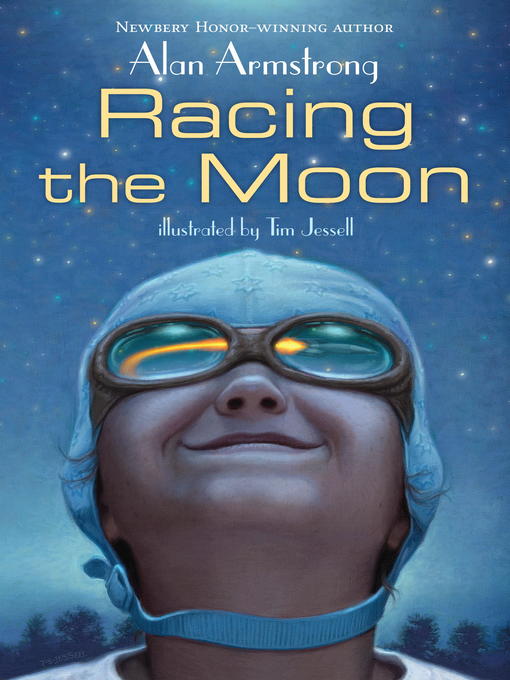
Racing the Moon
فرمت کتاب
ebook
تاریخ انتشار
2012
Lexile Score
780
Reading Level
3-4
ATOS
4.9
Interest Level
4-8(MG)
نویسنده
Tim Jessellشابک
9780375893094
کتاب های مرتبط
- اطلاعات
- نقد و بررسی
- دیدگاه کاربران
نقد و بررسی

April 30, 2012
In 1947, 11-year-old Alexis and her unpredictable 17-year-old brother, Chuck, have a big dream: to go to Mars. Self-described “student of space,” they’ve built a “moon station” tree house, researched radar, and are planning to build their own rocket using real gunpowder. When they meet Captain Ebbs,
a (real-life) army scientist who develops food for pilots, she, unlike other adults, takes them seriously and encourages them to plan their scientific career. At Ebbs’s invitation, the siblings join the scientist on a sailing trip down the Potomac River to watch a secret rocket launch, following in the footsteps of Ebbs’s distant relative Capt. John Smith. Middle-grade–friendly versions of Smith’s journals are woven throughout the latter half of the book, revealing the similarities of their adventures. Newbery Honor author Armstrong (Whittington) works a good deal of scientific and historical information into his story without affecting its pace, energy, or style. It’s a lively historical adventure with ready appeal to space enthusiasts and those with an appetite for adventure. Final art not seen by PW. Ages 8–12.

April 1, 2012
Obsessed with rocket-building and outer space, two siblings living in Silver Springs, Md., in 1947 find the perfect ally right next door. Twelve-year-old Alex hangs out with her reckless 17-year-old brother Chuck, who's always getting them in trouble. Fascinated with radios, radar and rockets, Chuck "can make anything, " but was kicked out of tech school because he "mixes things up when he reads." Alex's mother urges her to "act more ladylike," dress more carefully and pay more attention to schoolwork, but tomboy Alex wants to be another Amelia Earhart. Meeting her new neighbor, Captain Ebbs, Alex finds a mentor who develops space food for the army, sails her own boat and is a descendant of Captain John Smith. Beneath their impulsive behavior, Ebbs recognizes that Alex and Chuck share her passion for aviation and space. She arranges for Alex to meet pioneer rocket scientist Wernher von Braun, organizes a sailing trip to a Chesapeake Bay island near a rocket launch and provides needed direction for the risk-taking duo. Inspired by the real Joan Cotton Ebbs, this chronicle of sibling aeronautical aspiration and misadventure provides a peek at the post-World War II U.S. space program. Realistic pencil-sketch illustrations capture key events. High-flying adventure grounded in reality. (suggestions for further reading) (Historical fiction. 8-12)
COPYRIGHT(2012) Kirkus Reviews, ALL RIGHTS RESERVED.

August 1, 2012
Gr 5-7-World War II is over and, like many American kids, 11-year-old Alex and her 17-year-old brother, Chuck, are fascinated with space science. They build model rockets, read and study about radio codes, and even have a tree house equipped as a Moon Station. They are excited to discover that their new neighbor, Captain Ebbs, is actually part of the space research program, and that she works with pioneer space scientist Wernher von Braun. Ebbs is impressed by the kids' research, but not at all happy with Chuck's tendency to "liberate" materials for his experiments from local stores. Hoping to encourage a more acceptable lifestyle, she invites the children to join her on a sailing expedition down the Potomac to observe a top-secret rocket launch. In many ways, their trip will resemble a space voyage. The travelers will be on their own "out there," Ebbs says. Success will require cooperation and self-reliance and a readiness to adapt. However, while the captain plans to watch the blastoff from a safe-and legal-distance, Chuck insists on a closer view. Despite armed guards, the FBI, and the presence of von Braun himself, the siblings resolve to sneak onto the restricted island. The quiet, leisurely pacing of the action recalls the generally peaceful atmosphere of rural America in the postwar years. However, there are subtle reminders of the conflicts that lie just below the surface and that will shortly erupt onto the national scene-communism, xenophobia, militarism. With realistic dialogue, authentic period details, and references to historical figures and events, this novel brings to life an important, but often overlooked, era in American and scientific history.-Elaine E. Knight, Lincoln Elementary Schools, IL
Copyright 2012 School Library Journal, LLC Used with permission.

June 1, 2012
Grades 5-8 It's 1947, and 11-year-old Ally and her older brother, Chuck, are obsessed with the emerging science of rocketry. When Ally learns that a neighbor, Captain Ebbs, is a military scientist, she delights in hearing about the woman's work with the captured German scientist Wernher von Braun (designer of the infamous V-2 rocket). She also gets caught up in Chuck's reckless information-gathering adventures, like scaling a radio tower to see firsthand how signals are broadcast. Ebbs takes the kids under her wing, and they set off on a sailing trip to an island where they might be able to watch a test launch from afar. But nothing short of being at the launch is good enough for Chuck and Ally. Though the point of view centers on Ally, the book's true character arc belongs to Chuck, which makes for an emotionally removed read with too many competing subplots. Still, Armstrong (with the help of Jessell's spot art) captures the essence of youthful pluck, and Chuck's determination to learn at all costs is something that readers can admire.(Reprinted with permission of Booklist, copyright 2012, American Library Association.)

























دیدگاه کاربران